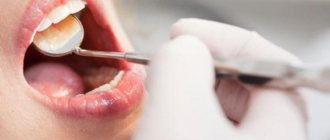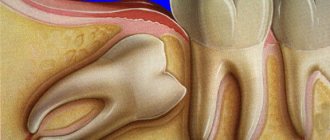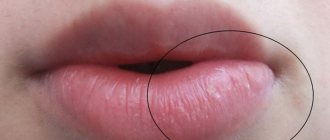- Why a temporary filling is placed: types of material
- Why does a tooth with a temporary filling hurt: the main reasons
- Standard activities after installation of the material
- Temporary filling hurts when pressed: how to cope with the disease
Many patients complain to dentists that their tooth hurts under a temporary filling. For the first 2-3 days, a slight aching pain is considered normal and does not cause cause for concern or panic. It is associated with the active influence of drugs on the nerve endings of the molar or premolar.
If the temporary filling hurts very strongly and for a long time when pressed, it is recommended to make an appointment with a specialist earlier than the specified date. Dentists at the reliable A-Medic clinic will conduct a thorough examination and prescribe a diagnostic examination to find out what exactly is causing the pain. All people are scared that they have had a temporary filling installed and their tooth hurts, but most often there is no reason to worry.
Why a temporary filling is placed: types of material
Non-permanent filling is a mandatory measure in the treatment of complicated carious lesions and root canal inflammation. It is required for medicinal treatment of an inflamed molar or premolar. It is entrusted with the protective function of the treated cavity from food ingress. Also, it prevents the medical pad from falling out.
The composition of such material differs significantly from a permanent filling. It can be made from water-insoluble or plastic components. The choice of the most suitable material directly depends on the condition of the molar or premolar and the purpose of the installation. Among the most common materials are:
- sympath. It can be of different shades - white (for filling non-pulp teeth) or light pink. The mass does not provoke irritation and other allergic reactions;
- dentin paste. It reliably protects the tooth from staining with amalgams and is characterized by water-repellent properties. The paste hardens in 100-120 minutes;
- zinc polyacrylate cement. It is characterized by good biocompatibility with tissues and high strength. The material is used for fixing prostheses (crowns) or filling (both permanent and baby teeth);
- Vinoxol. It is characterized by reliability and durability, capable of maintaining integrity for up to 4-5 months. The drug has antiseptic properties, which allows you to disinfect the tooth cavity. It hardens in 3-4 hours.
There are situations when the carious lesion did not have time to reach the nerve. In such cases, the molar or premolar is not depulped, but temporary material is installed. This is necessary for diagnosis to see whether the tooth will become sensitive or not. With the help of these measures, it is possible to completely preserve a molar or premolar (without removing the nerve) if the patient does not experience pain. If a pronounced reaction occurs (if the temporary filling hurts), the dentist will remove the nerve after placing a filling with arsenic.
Often, non-permanent filling is resorted to during prosthetics. This allows you to protect the molar or premolar from pathogenic microorganisms. The wearing period is individual and directly depends on the type of material and the reason why filling was required. It is installed by the attending dentist. On average, after 7-10, specialists replace it with a permanent filling. Sometimes, after applying a temporary filling, a tooth hurts; let’s figure out what could cause this phenomenon.
Causes of cheek swelling after dental treatment.
It should be noted right away: such a picture may be a natural consequence of the treatment itself. If the cheek is swollen after tooth treatment, but recovers in a matter of hours, then we are talking about normal post-therapeutic swelling.
In addition, people suffering from hypertension (high blood pressure) may experience bleeding for a long time after surgery, even the simplest one, along with a swollen cheek.
Most often, a person discovers that his cheek is swollen after tooth extraction. However, such situations are also considered normal. Indeed, during the extraction of a tooth from the alveoli, tissues are damaged and many vessels are torn, and this, naturally, leads to swelling of the gums, and with it half of the face. Our doctors always inform their patients about this consequence before tooth extraction surgery, and after it they tell them how to reduce pain and eliminate inflammation in a matter of hours.
In all other cases, edema is considered a pathology that needs to be eliminated, and very urgently.
Attention! If after dental treatment your cheek is swollen, but has not recovered within two days, immediately contact your dentist. The sooner you do this, the sooner he will carry out all the necessary examinations, identify the cause of the pathology, eliminate the tumor and thereby prevent the development of serious complications, including gum suppuration. And, if pus has already formed in such a short period of time, then a dental surgeon will get down to business and eliminate the source of infection. You will then undergo a therapeutic course of treatment using injections or oral medications.
Why does a tooth with a temporary filling hurt: the main reasons
Often, patients with a temporary filling have a toothache when pressed. In some cases, such a reaction is considered normal. The attending physician will be able to answer for sure why a tooth hurts after a temporary filling after examining the oral cavity and conducting a diagnostic examination. Let's take a closer look at the main reasons for the appearance of pronounced discomfort sensations:
- Impact of the drug. If a tooth hurts with a temporary filling and medication, then most often the source of discomfort is its effect on the tissue. You should contact a specialist if the pain is pronounced and reduces the quality of life.
- Unfinished therapy. Often, after the pain has subsided, a person decides to stop therapy and does not come to an appointment to replace it with a permanent material. Temporary material is not intended to be worn for several years, so sooner or later it will fall out. It is recommended to replace at the appointed time.
- Allergic reaction to cementitious agent. If a tooth with a temporary filling aches and hurts a lot, the reason may lie in an allergic reaction. In such a situation, it would be more advisable to replace it with another cementing agent (depending on the period of wear).
- Lack of material. There is a high probability that it fell out while drinking or eating food, so external factors (irritants) come into direct contact with the soft tissues. An infection could have entered the tooth cavity, causing an inflammatory reaction.
- Prolonged wearing of the cementing agent (longer than the prescribed period). The material is quite fragile; when worn for a long time, it begins to lose its tightness, allowing pathogenic microorganisms (bacteria) to enter the cavity of the molar or premolar.
The biggest cause for concern is discomfort after installation of permanent material. This is an alarming signal that may indicate incorrect installation, untreated pathology, or emerging complications. In this situation, you need to make an appointment with a specialist to determine the main source of pain.
Standard activities after installation of the material
Do not drink or eat until the material has completely hardened, as it may crack or fall out completely. Also, food can get into the cavity of a molar or premolar. After a non-permanent filling, it is not recommended to eat soft food for the first 2-3 hours, and hard food for 10-12 hours. This will avoid a number of negative consequences. When chewing solid food in the future, you should use less of the side on which the filling was performed.
While wearing the material, hygiene rules must not be neglected. You should brush your teeth twice a day, and after eating, rinse your mouth with antiseptic solutions and floss. If the temporary material is installed for several months, it is recommended to use a brush with softer bristles during this period. To avoid possible complications, the material is removed on a strictly designated day.
Causes of pain
Various reasons can lead to a situation where the gums hurt after filling.
These are mainly dental reasons and the reaction of the patient’s body:
| The doctor contributed to the development of pain | Patient's reaction |
| Diagnostic problems | Allergy to solutions and materials used in the treatment of complicated forms of caries |
| Choosing an inadequate clinical situation tactics | |
| Errors in the process of processing canals: with instruments, solutions, at the stage of filling canals and placing a filling |
Typically, after conservative therapy, the patient should feel mild pain, which intensifies when biting for 2-3 hours after the end of the intervention. But in some cases, pain can persist for a longer time.
If your gums hurt after canal filling for more than 2-3 days, you should urgently consult a doctor in order to prevent the occurrence of post-filling complications. Delay may threaten the deterioration of the general condition of the body.
Errors in diagnosis and tactics
Tooth tissue consists of hard and soft fragments that are combined into one and installed in the bone socket of the jaw. The participation of certain dental elements in the disease and the degree of infection penetration affect the manifestation of symptoms, which directly determine the choice of diagnostic methods and the subsequent development of treatment tactics.
Complicated forms of caries affect all tooth structures:
- enamel;
- dentine;
- pulp;
- periodontium.
Pulpitis is located within the tissues of the tooth. Periodontitis is characterized by the presence of inflammation in the area of the root apex, with destruction processes affecting the periapical area of the jaw.
Variants of forms of complicated caries, accompanied by damage to certain tooth structures.
Pulpitis and periodontitis go through several stages in their development:
- jet;
- chronic;
- exacerbation of chronic
Each variant of the course of the disease has its own clinical situation. Thus, pulpitis is often characterized by the presence of paroxysmal night pains, progressively intensifying from a cold stimulus. With periodontitis, aching pain and temperature stimuli do not cause a reaction in the patient.
Carrying out an X-ray examination in the complicated course of the carious process is mandatory. In some cases, it is not possible to perform it due to the low equipment of the dental clinic. Typically, periodontitis is accurately diagnosed based on the image, based on the presence of bone loss in the area of the tooth apex.
An accurate diagnosis of periodontitis can be made by conducting an X-ray examination.
In a situation where a doctor, examining a tooth cavity and evaluating X-ray data, comes to an erroneous diagnosis and choice of tactics, even if all the rules of asepsis and antisepsis are observed, there will be a high probability that pain in the gums will appear after filling.
Violations at the stages of canal treatment and fillings
The doctor placed a filling, but the tooth may continue to react when chewed. This may be due to errors in the processing of the root canal system.
Mechanical cleansing of the canal space implies:
- Complete removal of putrid masses (necrotic contents during periodontitis), pulp;
- Elimination of the smear layer in the area of the dentinal tubules.
This is achieved by carefully performing endodontic intervention manually and mechanically. If irregularities are left around the perimeter of the canal, then in the future it will not be possible to ensure a tight fit of the root filling. In addition, excessive and incorrect treatment can lead to thinning of the canal walls and perforation.
The use of special instruments for performing endodontics should be mandatory when infection penetrates into the root canal systems.
A tooth can also become ill if the rules of antiseptic treatment are not followed, both in terms of using instruments and when irrigating the canals with solutions. Each patient should be treated only with sterile instruments.
During mechanical processing, irrigation with antiseptics should be carried out regularly. This is due to the fact that it is not always possible to completely remove microbial flora from the canal lumen manually or mechanically.
For this purpose, a number of antimicrobial drugs are used:
- Chlorhexidine bigluconate solution 2%;
- Hydrogen Peroxide solution 3%;
- belodez 3-5%.
Pain when biting can occur after mistakes are made at the stage of placing a root filling. Insufficient obturation of the lumen, improper mixing and introduction of materials into the canal cavity can cause subsequent pain.
The x-ray photo shows violations of the technique of obturating the tooth canals after mechanical and medicinal treatments.
When restoring the crown of a tooth with filling material or an orthopedic crown, pain in the gums can subsequently be provoked when applied to the mucous tissue. This happens when there is no use of special devices for filling contact points (matrix, wedges) or when the crown is significantly advanced at the fixation stage.
Allergic reaction of the patient
Note! If the treatment is carried out correctly, based on the clinical and additional examination data, but the tooth still hurts in the gum area, another cause of discomfort should be suspected. Most often, the patient develops an allergy to the solutions and materials used.
Allergies may occur after root canal filling due to the dental materials used.
In addition to local changes in the form of pain and swelling in the gums, hyperemia, general disorders occur:
- health worsens;
- temperature appears;
- characterized by weakness.
Rashes can appear both in the mouth and on the skin. Often such changes begin to appear during or immediately after treatment. However, if therapy is completed and an allergy appears, then to prevent the development of anaphylactic shock and Quincke's edema, it is important to immediately consult a doctor.
Temporary filling hurts when pressed: how to cope with the disease?
People often ask the question: “if you have a temporary filling installed and your tooth hurts, what should you do?” When a tooth hurts under a temporary filling, this is a normal condition, do not panic. If the dentist said that there is no cause for concern, you should be patient and wait out the unpleasant symptom. When a temporary filling causes severe pain in a tooth, and you run out of strength to endure the pain, you can use the following recommendations:
- rinse your mouth with antiseptic and soothing solutions. You can prepare them yourself at home from natural ingredients. For example, chamomile and sage are poured with boiling water and the resulting product is used to rinse the mouth;
- do not allow food and drinks (mainly hot or cold) to come into contact with the treated tooth;
- take a painkiller (analgesic). “Nise” and “Ketorol” give good results;
- make lotions with valerian tincture. A moistened cotton swab of valerian is applied to the painful area, the gum near the tooth. This will temporarily relieve the irritation.
If a tooth hurts after installing a temporary filling and swelling or redness of the soft tissue appears, this may indicate the presence of an inflammatory process or the appearance of pus. In such a situation, you should re-make an appointment with a dentist-therapist. The A-Medic clinic employs qualified specialists with extensive experience. To make an appointment, just fill out the standard form on the official website of the clinic (indicating your full name and contact number). Prices are affordable, and consultation with a dentist is completely free.











